Matplotlib等高线绘制:掌握数据可视化的精髓
Matplotlib是Python中最流行的数据可视化库之一,而等高线(contour lines)绘制是其中一个强大而versatile的功能。等高线图能够直观地展示三维数据在二维平面上的分布,广泛应用于地形图、天气图、热力图等领域。本文将深入探讨Matplotlib中等高线的绘制技巧,从基础概念到高级应用,帮助你全面掌握这一数据可视化利器。
1. 等高线基础
等高线是连接具有相同高度或值的点的曲线。在Matplotlib中,我们使用contour()和contourf()函数来绘制等高线图。
1.1 基本等高线图
让我们从一个简单的例子开始:
import numpy as np
import matplotlib.pyplot as plt
x = np.linspace(-5, 5, 100)
y = np.linspace(-5, 5, 100)
X, Y = np.meshgrid(x, y)
Z = np.sin(np.sqrt(X**2 + Y**2))
plt.figure(figsize=(10, 8))
plt.contour(X, Y, Z)
plt.title('Basic Contour Plot - how2matplotlib.com')
plt.xlabel('X')
plt.ylabel('Y')
plt.show()
Output:

在这个例子中,我们创建了一个简单的二维函数Z = sin(sqrt(X^2 + Y^2)),然后使用contour()函数绘制等高线。np.meshgrid()函数用于创建网格点坐标。
1.2 填充等高线图
如果我们想要填充等高线之间的区域,可以使用contourf()函数:
import numpy as np
import matplotlib.pyplot as plt
x = np.linspace(-5, 5, 100)
y = np.linspace(-5, 5, 100)
X, Y = np.meshgrid(x, y)
Z = np.sin(np.sqrt(X**2 + Y**2))
plt.figure(figsize=(10, 8))
plt.contourf(X, Y, Z, cmap='viridis')
plt.colorbar(label='Z value')
plt.title('Filled Contour Plot - how2matplotlib.com')
plt.xlabel('X')
plt.ylabel('Y')
plt.show()
Output:

这个例子使用了contourf()函数来创建填充的等高线图。我们还添加了一个颜色条来显示Z值的范围。
2. 自定义等高线
Matplotlib提供了多种方式来自定义等高线的外观和行为。
2.1 设置等高线级别
我们可以通过指定levels参数来控制等高线的数量和位置:
import numpy as np
import matplotlib.pyplot as plt
x = np.linspace(-5, 5, 100)
y = np.linspace(-5, 5, 100)
X, Y = np.meshgrid(x, y)
Z = np.sin(np.sqrt(X**2 + Y**2))
plt.figure(figsize=(10, 8))
levels = [-0.5, 0, 0.5]
cs = plt.contour(X, Y, Z, levels=levels)
plt.clabel(cs, inline=True, fontsize=10)
plt.title('Custom Contour Levels - how2matplotlib.com')
plt.xlabel('X')
plt.ylabel('Y')
plt.show()
Output:
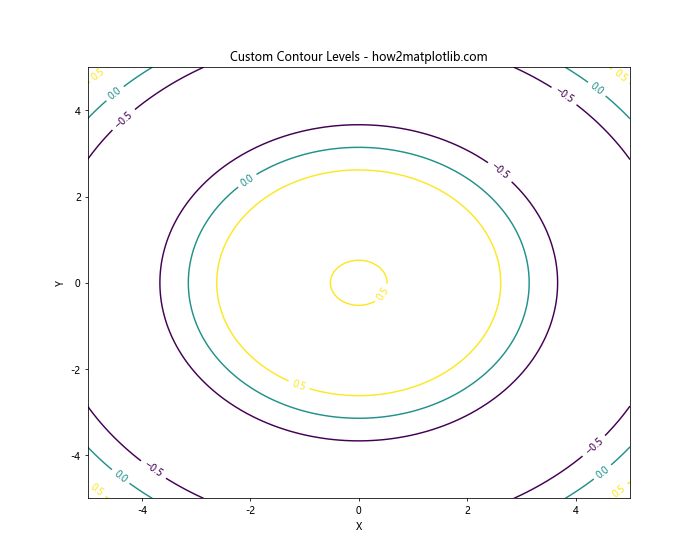
在这个例子中,我们指定了三个等高线级别:-0.5, 0, 和0.5。plt.clabel()函数用于在等高线上添加标签。
2.2 自定义等高线颜色
我们可以为每个等高线指定不同的颜色:
import numpy as np
import matplotlib.pyplot as plt
x = np.linspace(-5, 5, 100)
y = np.linspace(-5, 5, 100)
X, Y = np.meshgrid(x, y)
Z = np.sin(np.sqrt(X**2 + Y**2))
plt.figure(figsize=(10, 8))
levels = [-0.5, 0, 0.5]
colors = ['blue', 'green', 'red']
cs = plt.contour(X, Y, Z, levels=levels, colors=colors)
plt.clabel(cs, inline=True, fontsize=10)
plt.title('Custom Contour Colors - how2matplotlib.com')
plt.xlabel('X')
plt.ylabel('Y')
plt.show()
Output:
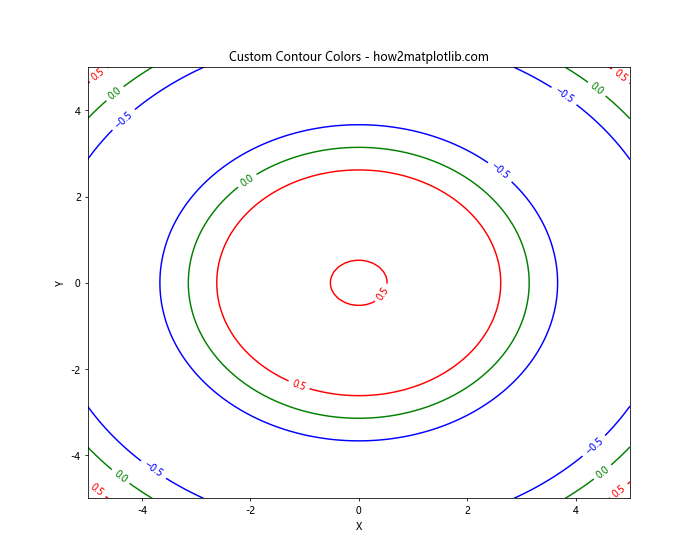
这个例子为每个等高线级别指定了不同的颜色。
3. 等高线标签
等高线标签可以帮助读者更好地理解数据。
3.1 基本标签
我们可以使用clabel()函数来添加等高线标签:
import numpy as np
import matplotlib.pyplot as plt
x = np.linspace(-5, 5, 100)
y = np.linspace(-5, 5, 100)
X, Y = np.meshgrid(x, y)
Z = np.sin(np.sqrt(X**2 + Y**2))
plt.figure(figsize=(10, 8))
cs = plt.contour(X, Y, Z)
plt.clabel(cs, inline=True, fontsize=10)
plt.title('Contour Plot with Labels - how2matplotlib.com')
plt.xlabel('X')
plt.ylabel('Y')
plt.show()
Output:

这个例子在等高线上添加了标签,显示每条线的Z值。
3.2 自定义标签格式
我们可以自定义标签的格式:
import numpy as np
import matplotlib.pyplot as plt
x = np.linspace(-5, 5, 100)
y = np.linspace(-5, 5, 100)
X, Y = np.meshgrid(x, y)
Z = np.sin(np.sqrt(X**2 + Y**2))
plt.figure(figsize=(10, 8))
cs = plt.contour(X, Y, Z)
plt.clabel(cs, inline=True, fontsize=10, fmt='%1.2f')
plt.title('Contour Plot with Custom Label Format - how2matplotlib.com')
plt.xlabel('X')
plt.ylabel('Y')
plt.show()
Output:

在这个例子中,我们使用fmt参数来指定标签的格式,显示两位小数。
4. 等高线与其他图形元素结合
等高线图可以与其他图形元素结合,创造出更丰富的可视化效果。
4.1 等高线与散点图结合
我们可以在等高线图上添加散点图:
import numpy as np
import matplotlib.pyplot as plt
x = np.linspace(-5, 5, 100)
y = np.linspace(-5, 5, 100)
X, Y = np.meshgrid(x, y)
Z = np.sin(np.sqrt(X**2 + Y**2))
plt.figure(figsize=(10, 8))
plt.contourf(X, Y, Z, cmap='viridis', alpha=0.8)
plt.colorbar(label='Z value')
# 添加散点
scatter_x = np.random.uniform(-5, 5, 50)
scatter_y = np.random.uniform(-5, 5, 50)
plt.scatter(scatter_x, scatter_y, c='red', s=50)
plt.title('Contour Plot with Scatter Points - how2matplotlib.com')
plt.xlabel('X')
plt.ylabel('Y')
plt.show()
Output:

这个例子在填充的等高线图上添加了随机散点。
4.2 等高线与向量场结合
我们可以将等高线图与向量场结合,展示梯度信息:
import numpy as np
import matplotlib.pyplot as plt
x = np.linspace(-5, 5, 20)
y = np.linspace(-5, 5, 20)
X, Y = np.meshgrid(x, y)
Z = np.sin(np.sqrt(X**2 + Y**2))
plt.figure(figsize=(10, 8))
plt.contourf(X, Y, Z, cmap='viridis', alpha=0.8)
plt.colorbar(label='Z value')
# 计算梯度
dx, dy = np.gradient(Z)
plt.quiver(X, Y, dx, dy)
plt.title('Contour Plot with Vector Field - how2matplotlib.com')
plt.xlabel('X')
plt.ylabel('Y')
plt.show()
Output:
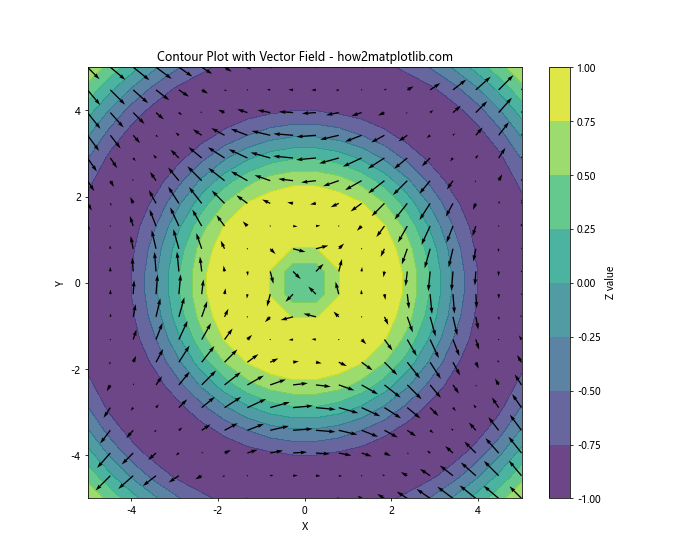
这个例子展示了如何在等高线图上添加向量场,表示Z的梯度。
5. 3D等高线图
Matplotlib还支持绘制3D等高线图,这可以更直观地展示三维数据。
5.1 基本3D等高线图
让我们创建一个基本的3D等高线图:
import numpy as np
import matplotlib.pyplot as plt
from mpl_toolkits.mplot3d import Axes3D
x = np.linspace(-5, 5, 100)
y = np.linspace(-5, 5, 100)
X, Y = np.meshgrid(x, y)
Z = np.sin(np.sqrt(X**2 + Y**2))
fig = plt.figure(figsize=(10, 8))
ax = fig.add_subplot(111, projection='3d')
ax.contour(X, Y, Z, cmap='viridis')
ax.set_title('3D Contour Plot - how2matplotlib.com')
ax.set_xlabel('X')
ax.set_ylabel('Y')
ax.set_zlabel('Z')
plt.show()
Output:

这个例子创建了一个基本的3D等高线图。
5.2 3D等高线图与曲面图结合
我们可以将3D等高线图与曲面图结合:
import numpy as np
import matplotlib.pyplot as plt
from mpl_toolkits.mplot3d import Axes3D
x = np.linspace(-5, 5, 100)
y = np.linspace(-5, 5, 100)
X, Y = np.meshgrid(x, y)
Z = np.sin(np.sqrt(X**2 + Y**2))
fig = plt.figure(figsize=(10, 8))
ax = fig.add_subplot(111, projection='3d')
ax.plot_surface(X, Y, Z, cmap='viridis', alpha=0.8)
ax.contour(X, Y, Z, zdir='z', offset=-1, cmap='viridis')
ax.set_title('3D Surface with Contour Plot - how2matplotlib.com')
ax.set_xlabel('X')
ax.set_ylabel('Y')
ax.set_zlabel('Z')
plt.show()
Output:
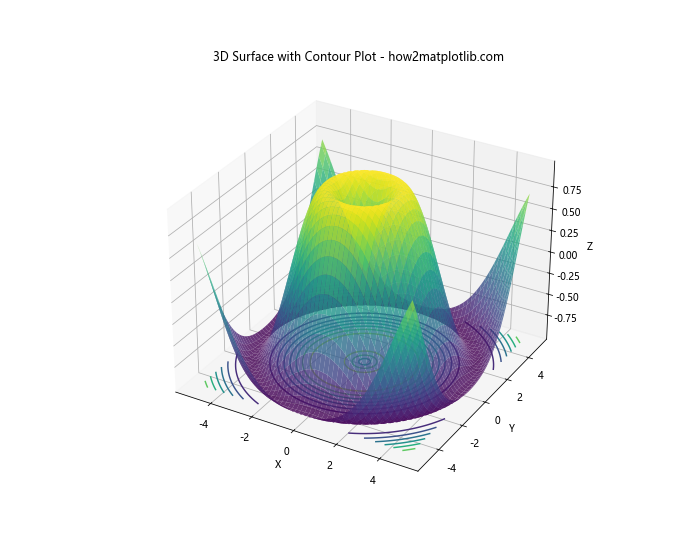
这个例子展示了如何将3D曲面图与底部的等高线图结合。
6. 高级等高线技巧
接下来,我们将探讨一些高级的等高线绘制技巧。
6.1 不规则网格上的等高线
有时我们需要在不规则的网格上绘制等高线:
import numpy as np
import matplotlib.pyplot as plt
from scipy.interpolate import griddata
# 创建不规则点
np.random.seed(0)
x = np.random.rand(1000) * 4 - 2
y = np.random.rand(1000) * 4 - 2
z = x * np.exp(-x**2 - y**2)
# 创建规则网格
xi = np.linspace(-2, 2, 100)
yi = np.linspace(-2, 2, 100)
Xi, Yi = np.meshgrid(xi, yi)
# 插值
Zi = griddata((x, y), z, (Xi, Yi), method='cubic')
plt.figure(figsize=(10, 8))
plt.contourf(Xi, Yi, Zi, cmap='viridis')
plt.colorbar(label='Z value')
plt.scatter(x, y, c='red', s=1)
plt.title('Contour Plot on Irregular Grid - how2matplotlib.com')
plt.xlabel('X')
plt.ylabel('Y')
plt.show()
Output:

这个例子展示了如何在不规则的点上创建等高线图,使用scipy.interpolate.griddata进行插值。
6.2 等高线图动画
我们可以创建等高线图的动画:
import numpy as np
import matplotlib.pyplot as plt
from matplotlib.animation import FuncAnimation
x = np.linspace(-5, 5, 100)
y = np.linspace(-5, 5, 100)
X, Y = np.meshgrid(x, y)
fig, ax = plt.subplots(figsize=(10, 8))
def animate(i):
Z = np.sin(np.sqrt(X**2 + Y**2) - i * 0.1)
ax.clear()
cs = ax.contourf(X, Y, Z, cmap='viridis')
ax.set_title(f'Animated Contour Plot - Frame {i} - how2matplotlib.com')
ax.set_xlabel('X')
ax.set_ylabel('Y')
return cs
anim = FuncAnimation(fig, animate, frames=100, interval=50)
plt.show()
Output:
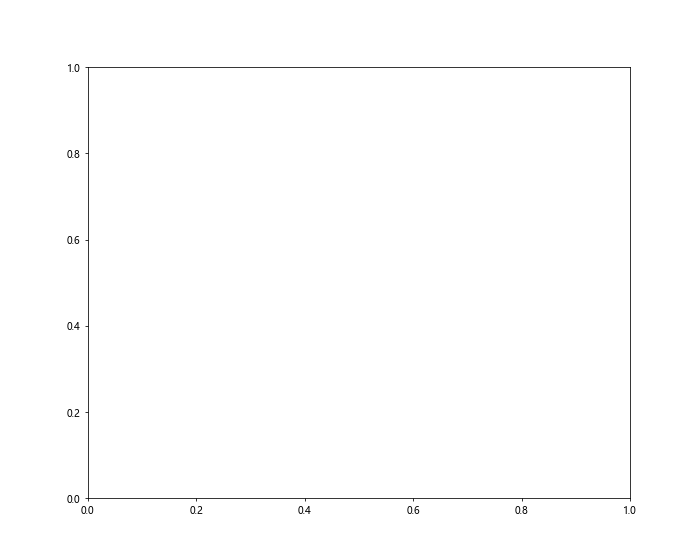
这个例子创建了一个简单的等高线图动画,展示了随时间变化的波动。
7. 等高线图的实际应用
等高线图在许多领域都有广泛的应用。让我们看几个实际的例子。
7.1 地形图
等高线图最常见的应用之一是绘制地形图:
import numpy as np
import matplotlib.pyplot as plt
def generate_terrain(size=100, peaks=5):
x = np.linspace(0, 1, size)
y = np.linspace(0, 1, size)
X, Y = np.meshgrid(x, y)
Z = np.zeros((size, size))
for _ in range(peaks):
x0, y0 = np.random.rand(2)
sigma = np.random.rand() * 0.1 + 0.05
amplitude = np.random.rand() * 500 + 500
Z += amplitude * np.exp(-((X-x0)**2 + (Y-y0)**2) / (2*sigma**2))
return Z
terrain = generate_terrain()
plt.figure(figsize=(12, 9))
cs = plt.contour(terrain, levels=20, cmap='terrain')
plt.clabel(cs, inline=True, fontsize=8, fmt='%1.0f')
plt.title('Terrain Contour Map - how2matplotlib.com')
plt.xlabel('X')
plt.ylabel('Y')
plt.colorbar(label='Elevation (m)')
plt.show()
Output:

这个例子生成了一个简单的地形图,使用等高线来表示不同的海拔高度。
7.2 天气图
等高线图在气象学中也有广泛应用,比如绘制气压图:
import numpy as np
import matplotlib.pyplot as plt
def generate_pressure_map(size=100):
x = np.linspace(0, 1, size)
y = np.linspace(0, 1, size)
X, Y = np.meshgrid(x, y)
Z = 1013 + 10 * np.sin(5*X) * np.cos(5*Y) + np.random.randn(size, size)
return Z
pressure = generate_pressure_map()
plt.figure(figsize=(12, 9))
cs = plt.contour(pressure, levels=np.arange(990, 1030, 2), colors='k')
plt.clabel(cs, inline=True, fontsize=8, fmt='%1.0f')
plt.contourf(pressure, cmap='RdYlBu_r', alpha=0.7)
plt.title('Pressure Contour Map - how2matplotlib.com')
plt.xlabel('Longitude')
plt.ylabel('Latitude')
plt.colorbar(label='Pressure (hPa)')
plt.show()
Output:
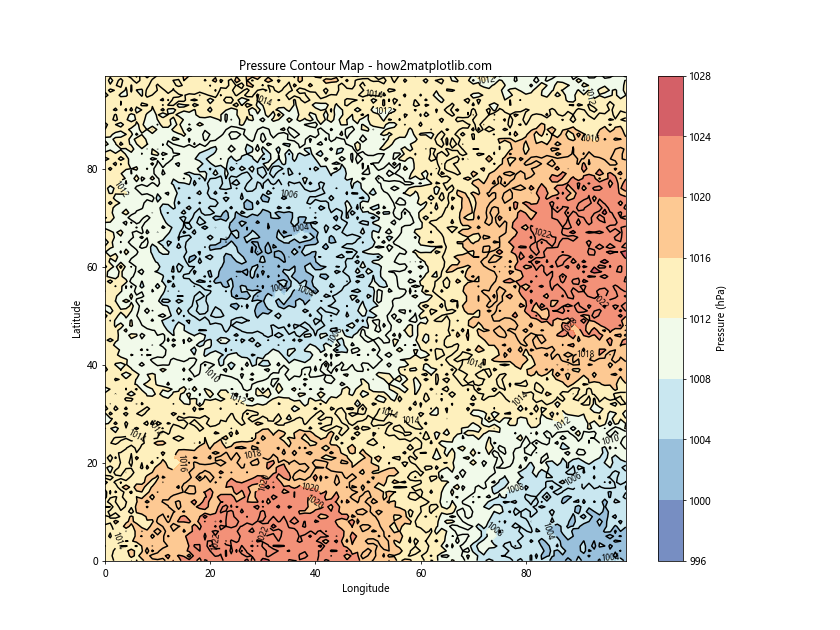
这个例子模拟了一个简单的气压图,使用等高线来表示不同的气压水平。
8. 等高线图的性能优化
当处理大型数据集时,等高线图的绘制可能会变得很慢。以下是一些优化技巧:
8.1 使用适当的数据类型
使用适当的数据类型可以显著提高性能:
import numpy as np
import matplotlib.pyplot as plt
# 使用float32而不是默认的float64
x = np.linspace(-5, 5, 1000, dtype=np.float32)
y = np.linspace(-5, 5, 1000, dtype=np.float32)
X, Y = np.meshgrid(x, y)
Z = np.sin(np.sqrt(X**2 + Y**2)).astype(np.float32)
plt.figure(figsize=(10, 8))
plt.contourf(X, Y, Z, levels=20, cmap='viridis')
plt.colorbar(label='Z value')
plt.title('Optimized Contour Plot - how2matplotlib.com')
plt.xlabel('X')
plt.ylabel('Y')
plt.show()
Output:
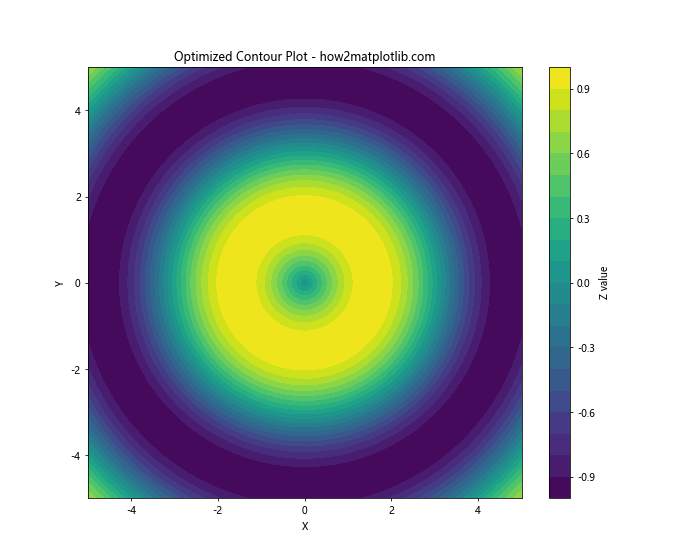
使用float32而不是默认的float64可以减少内存使用并提高计算速度。
8.2 减少等高线数量
减少等高线的数量可以显著提高绘图速度:
import numpy as np
import matplotlib.pyplot as plt
x = np.linspace(-5, 5, 1000)
y = np.linspace(-5, 5, 1000)
X, Y = np.meshgrid(x, y)
Z = np.sin(np.sqrt(X**2 + Y**2))
plt.figure(figsize=(10, 8))
plt.contourf(X, Y, Z, levels=10, cmap='viridis') # 使用较少的等高线
plt.colorbar(label='Z value')
plt.title('Contour Plot with Fewer Levels - how2matplotlib.com')
plt.xlabel('X')
plt.ylabel('Y')
plt.show()
Output:
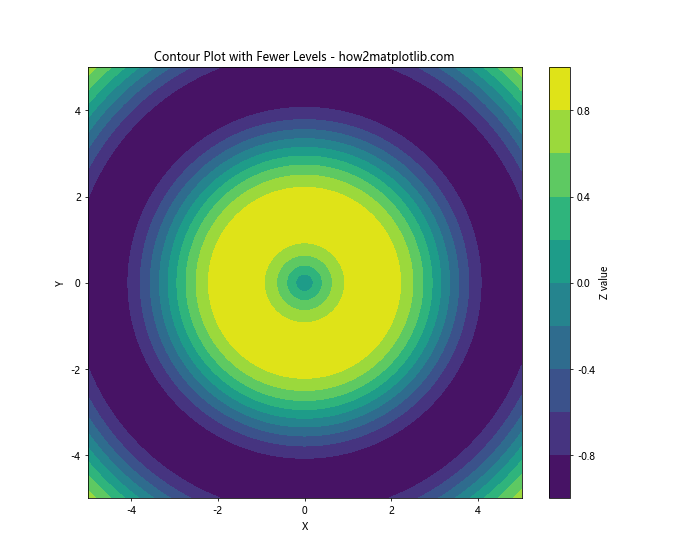
这个例子中,我们只使用了10个等高线级别,这可以显著提高大型数据集的绘图速度。
9. 等高线图的美化
最后,让我们看看如何美化等高线图,使其更具视觉吸引力。
9.1 使用自定义颜色映射
我们可以创建自定义的颜色映射来增强视觉效果:
import numpy as np
import matplotlib.pyplot as plt
from matplotlib.colors import LinearSegmentedColormap
x = np.linspace(-5, 5, 100)
y = np.linspace(-5, 5, 100)
X, Y = np.meshgrid(x, y)
Z = np.sin(np.sqrt(X**2 + Y**2))
# 创建自定义颜色映射
colors = ['#ff9999', '#66b3ff', '#99ff99', '#ffcc99']
n_bins = 100
cmap = LinearSegmentedColormap.from_list('custom_cmap', colors, N=n_bins)
plt.figure(figsize=(10, 8))
plt.contourf(X, Y, Z, cmap=cmap, levels=20)
plt.colorbar(label='Z value')
plt.title('Contour Plot with Custom Colormap - how2matplotlib.com')
plt.xlabel('X')
plt.ylabel('Y')
plt.show()
Output:
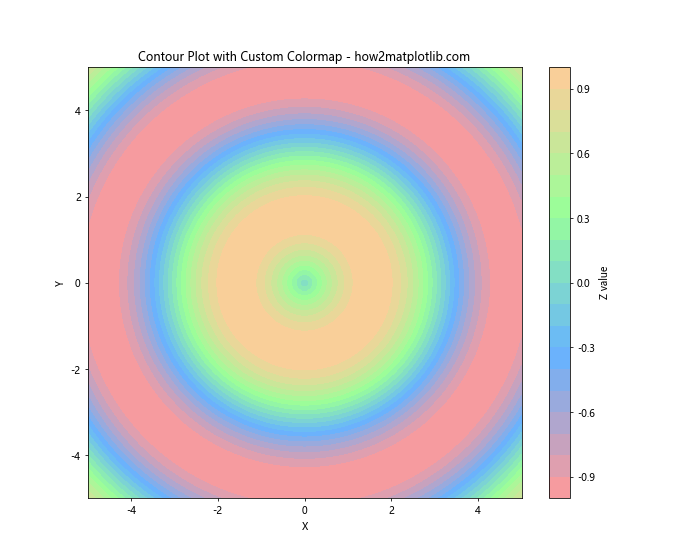
这个例子创建了一个自定义的颜色映射,使用柔和的pastel色调。
9.2 添加阴影效果
我们可以添加阴影效果来增强等高线图的立体感:
import numpy as np
import matplotlib.pyplot as plt
from matplotlib.colors import LightSource
x = np.linspace(-5, 5, 100)
y = np.linspace(-5, 5, 100)
X, Y = np.meshgrid(x, y)
Z = np.sin(np.sqrt(X**2 + Y**2))
fig, ax = plt.subplots(figsize=(10, 8))
# 创建光源
ls = LightSource(azdeg=315, altdeg=45)
rgb = ls.shade(Z, plt.cm.RdYlBu)
ax.imshow(rgb, extent=[-5, 5, -5, 5])
cs = ax.contour(X, Y, Z, colors='k', alpha=0.5)
ax.clabel(cs, inline=True, fontsize=8)
plt.title('Shaded Relief Contour Plot - how2matplotlib.com')
plt.xlabel('X')
plt.ylabel('Y')
plt.show()
Output:

这个例子使用LightSource类来创建阴影效果,增强了等高线图的立体感。
总结
通过本文,我们深入探讨了Matplotlib中等高线绘制的各个方面,从基础概念到高级应用。我们学习了如何创建基本的等高线图,如何自定义等高线的外观,如何添加标签,以及如何将等高线图与其他图形元素结合。我们还探讨了3D等高线图、不规则网格上的等高线绘制,以及等高线图的动画。此外,我们还讨论了等高线图在地形图和天气图等实际应用中的使用,以及如何优化和美化等高线图。
等高线图是一种强大的数据可视化工具,能够直观地展示三维数据在二维平面上的分布。掌握Matplotlib中的等高线绘制技巧,将使你能够更好地理解和展示复杂的数据集,无论是在科学研究、工程应用还是数据分析领域。
希望这篇文章能够帮助你全面掌握Matplotlib中的等高线绘制技巧,为你的数据可视化工作带来新的灵感和可能性。记住,实践是掌握这些技能的关键,所以不要忘记尝试文中的示例代码,并将其应用到你自己的项目中。祝你在数据可视化的journey中取得成功!
 极客教程
极客教程